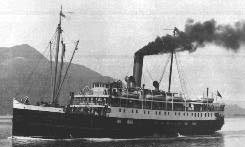It could have been so much worse

Maritime disasters are not strangers on the challenging and potentially lethal coast of British Columbia. Bearing that in mind, it is well to recall some earlier tragedies and be grateful that the sinking of the Queen of the North, despite the loss of the ship, did not take the human toll that some similar misadventures have.
As was printed in the Edmonton Morning Bulletin on Oct. 27, 1918, witness the following saga:
"Pounded by mountainous waves and driven before a wind of terrible severity, the Canadian Pacific steamship Princess Sophia slid from the comparative safety of Vanderbilt Reef in the Lynn Canal, midway between Skagway and Juneau, early Friday evening and carried 343 persons, passengers and crew, men, women and children, to their death in raging northern waters. There were no survivors from the ship."
It is testament to the crew and the passengers of the Queen of the North that virtually all did survive. The survival of those people also came about as a result of some amazingly good fortune, including the fact that there was a Coast Guard cutter in the immediate area (what are the odds?); that the mishap occurred very near to a settlement (there aren't many of them in the region); and that the ferry was sparsely occupied. Can you imagine the results if there had been a full summertime quotient of passengers and vehicles? Can you imagine how much more rapidly the stricken ship would have gone down if there had been the weight of maybe 100 cars and trucks on the vehicle deck, rather than a mere 16?
Of course, in an immediate impulse to equate this misfortune with others, headline writers tend to shoot for the top, and go immediately to the horrific tale of the Titanic back in 1912. The analogy other than Ship versus impediment, ship loses is not apt. In the first place, there was a horrific loss of life on the Titanic, secondly it happened well out to sea, and thirdly, it was not equipped with sufficient lifeboats. Ironically, however, the Titanic was constructed with a number of flotation chambers (which the Queen of the North was not), but they just didn't work very well, considering the nature of the iceberg impact which ripped a huge gash along a number of the compartments and rendered them useless. When they scrutinize our own ship, they might find compartments wouldn't have helped in this case, either.
All in all, however, it is well to bear in mind that BC's huge ferry fleet has been remarkably tragedy free in its years of operation. You are certainly safer taking a ferry than you are driving to the corner store for a quart of milk, all things considered. Furthermore, it behooves us all to offer up a bit of gratitude to the crew of that ship, and feel reassured that these men and women do know what they are doing when disaster strikes.
Now, of course, we can all sit around as spectators and wait for the massive amounts of litigation to begin to unfold. That should be entertaining. But, as we are sitting around waiting, we might also bear in mind that as exquisite as our coastline mine be, it's pretty damn treacherous. If you read a history of its legacy in terms of toll on ships, you will realize that the folk on the Queen of the North are mighty blessed people.


2 Comments:
Some really nice phrasology here Ian and I love this subject matter, the mystery of the lost ships, I could go on for ages.
Thank you so much for your kind comments. Am currently trying to think of an apt response to your fascinating barrister saga. I think it should go in the direction of a TV script. Wonderful tale that is so true.
Post a Comment
Subscribe to Post Comments [Atom]
<< Home